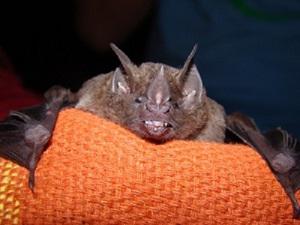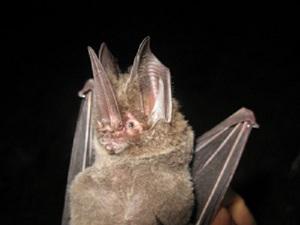Enrico Bernard
The aim of the project is to investigate the role of bats as seed dispersers and pollinators in a hyper fragmented landscape dominated by sugarcane, and with part of its mammal fauna locally extinct.

Artibeus obscurus (Dark fruit-eating bat).
One of the most dramatic examples of habitat loss and fragmentation worldwide is the Brazilian Atlantic Forest, where nearly only 7% of its original distribution remains. This situation is more critical in the north-eastern states of Pernambuco and Alagoas, areas largely dominated by sugarcane plantations. There are clear evidences that nearly 50% of the medium-sized and large mammal species once occurring in the fragments in Pernambuco are locally extinct, directly affecting the balance of ecological interactions in the area.

Lonchorhina aurita (Tomes's Sword-nosed Bat).
The degree of this process is disrupting ecological interaction networks and may trigger cascades of extinctions. With the extirpation of part of the local mammals, bats may have assumed a much more important ecological role, acting as the main remaining seed dispersers and pollinators in the forest fragments. But bats’ role may also be affected by declines in plant resources availability. Therefore, there is a clear need for a better understanding on the current role bats are playing in such fragmented and severely faunistically depauperated landscapes. In this project we will identify bat species using a hyper fragmented landscape composed by Atlantic Forest fragments surrounded by a matrix of sugarcane, study the mobility of target species in the fragmented landscape, calculate their movements, habitats used, investigate how they interact with a matrix of sugarcane surrounding the forest fragments, locate day and night roosts, estimate the home range of target species, quantify and qualify seed and pollen loads carried by bats, and investigate how the extirpation of other mammals may have affected bats’ role as seed dispersers and pollinators.
This project will produce scientific data suited to inform the civil society, governmental bodies and the private owners about the effects of forest fragmentation, the importance to maintain forested areas among the large and dominant sugarcane plantations and, in some cases, the necessity to re-establish forest connections among the remaining fragments. We will address ecological and behavioural questions essential to a better understanding of the effects of habitat fragmentation on seed dispersers and pollinators.
By quantifying pollen and seed loads being dispersed, we will contribute for a better recognition of bats as important agents for environmental services. Moreover, we will provide information towards a more sustainable model of agro-economy, addressing best conservational practices for the sector, and will also contribute with specialized human resources qualification in conservation biology.